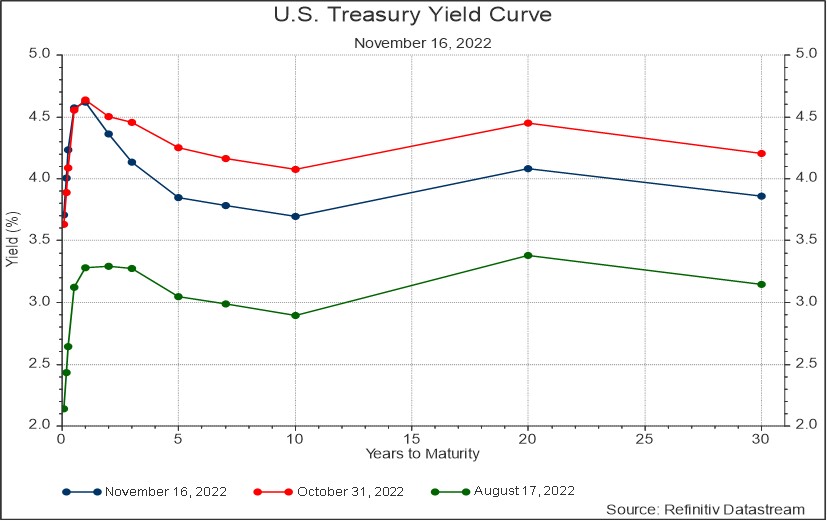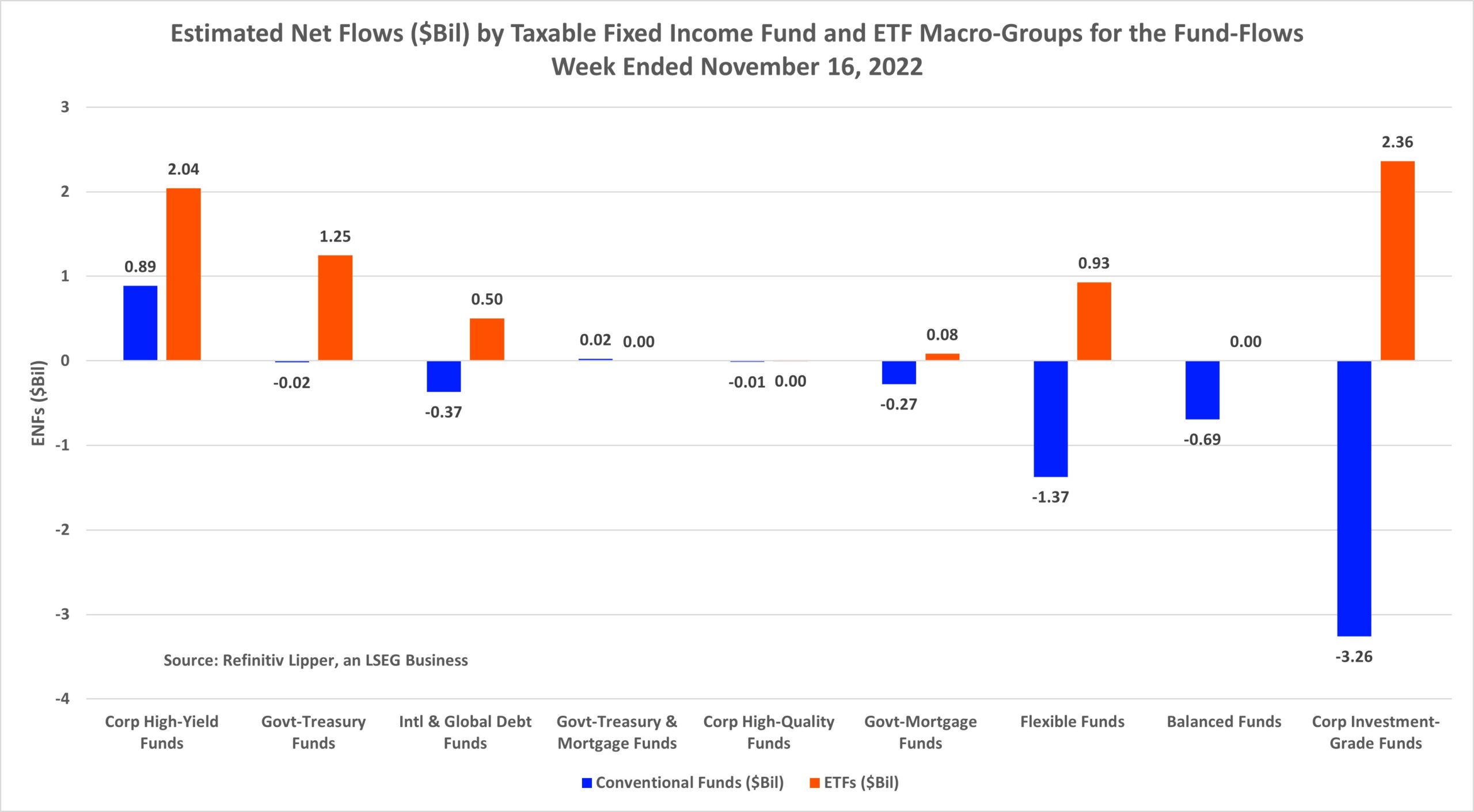During the Refinitiv Lipper fund-flows week ended November 16, 2022, fixed income funds and ETFs received a significant boost in returns after the October consumer price index (CPI) and producer price index (PPI) data showed signs inflation might be peaking.
As a result, taxable bond funds (including ETFs) took in net new money for the first week in nine, attracting $2.1 billion after posting their strongest one-week return (+2.47%) on record dating back to the week ended January 8, 1992, when Lipper began tracking weekly flows.
On the municipal bond fund and ETF side of the business, tax-exempt funds were also recipients of investors’ assets for the first week in 15, taking in a net $605 million this week after posting a one-week return of 2.40% (their third strongest one-week return on record), outpaced only by the 3.17% and 2.99% one-week gains witnessed on October 22, 2008, and January 14, 2009, respectively.
At the beginning of the fund-flows week, the U.S. Bureau of Labor Statistics reported that October headline inflation came in at a better-than-expected 0.4%, while core inflation weakened to 0.3%. The year-over-year rise in headline inflation slowed to 7.7% in October from 8.2% in September—leading many pundits to claim inflation had peaked and suggesting the expected December FOMC interest-rate hike will be a more modest 50 basis points (bps)—after witnessing four consecutive jumbo interest rate hikes of 75 bps over the last several months.
While yields at the shortest end of the curve continued to rise, the belly and long end of the curve witnessed significant declines. On the day the CPI report was released, the 10-year Treasury yield fell 30 bps, closing out the day at 3.82%, while the two-year Treasury yield declined 27 bps to 4.34%—its largest one-day decline since September 29, 2008. However, the one-month Treasury yield rose six bps on the day to close at 3.71% as the market priced in a 50-bps interest rate hike for December.
Reaction to the PPI report released later in the fund-flows week was a bit more muted, although also hinting at a possible peak in inflation, after Federal Reserve Governor Christopher Waller suggested that financial markets may have overreacted to the better-than-expected October CPI data last week, stating that “we’ve still got a ways to go.”
The U.S. October PPI rose 8% over the preceding 12 months, easing from September’s revised 8.4% increase. The 10-year Treasury yield declined eight bps to 3.80%, while the one-month yield rose an additional five bps to close at 3.77% on the day. At the end of the fund-flows week, the one-month Treasury yield, settled at 3.81%, rising above the 10-year yield of 3.67%—a result not seen since March 9, 2020, when the one-month and 10-year yields were at 0.57% and 0.54%, respectively.

Keeping in mind the inverse relationship between yields and prices for fixed income securities, the large decline in yields benefitted longer-dated fixed income classifications, with Lipper’s General U.S. Government Funds Index posting a 2.73% return for the fund-flows week (its strongest one-week return in at least the last 25 years), followed by the Lipper Short U.S. Government Funds Index rising 0.56% and the Lipper Ultra-Short Obligations Funds Index returning just 0.19%.
As indicated earlier, taxable bond funds (including ETFs) attracted a net $2.1 billion while their municipal bond fund counterparts took in $605 million for the most recent fund-flows week. However, the headline numbers don’t tell the complete story.
On the conventional funds side of the business (ex-ETFs), taxable bond funds handed back a net $5.1 billion for the week while their tax-exempt counterparts handed back some $1.2 billion. In contrast, on the ETF side of the ledger, taxable bond ETFs took in $7.2 billion and tax-exempt bond ETFs attracted a net $1.8 billion—their largest weekly net inflows on record dating back to the week ended September 12, 2007, when Lipper began tracking weekly estimated net flows for municipal bond ETFs.
ETF investors were net purchasers of corporate investment-grade debt ETFs (+$2.4 billion), corporate high-yield ETFs (+$2.0 billion), and government-Treasury ETFs (+$1.2 billion) for the week. iShares iBoxx $ High Yield Corporate Bond ETF (HYG, +$1.4 billion), iShares 20+ Year Treasury Bond (TLT, +$1.3 billion), and iShares iBoxx $ Investment Grade Corporate Bond ETF (LQD, +$1.1 billion) attracted the largest amounts of net new money of all individual taxable fixed income ETFs. Meanwhile, iShares Short Treasury Bond ETF (SHV, -$1.3 billion) and iShares 3-7 Year Treasury Bond ETF (IEI, -$601 million) handed back the largest individual net redemptions for the fund-flows week.
In contrast, on the conventional bond fund side of the business, the high-yield funds macro-group (+$889 million) attracted the largest amount of net new money of the taxable bond funds group for the week, followed by government-Treasury & mortgage funds (+$23 million). Corporate investment-grade debt funds (-$3.3 billion) suffered the largest net redemptions for the fund-flows week, bettered by flexible funds (-$1.4 billion) and balanced funds (-$691 million).

The General & Insured Municipal Bond ETFs (+$850 million), High-Yield Municipal Debt ETFs ($532 million), and Short/Intermediate Municipal Debt ETFs (+$126 million) classifications were the primary attractors of ETF investors’ assets for the fund-flows week. iShares National Municipal Bond ETF (MUB, +$584 million) witnessed the largest draw of net new money of the municipal bond ETFs, while Invesco California AMT-Free Muni Bond ETF (PWZ, -$4 million) experienced the largest net redemptions in the subgroup.
While the municipal bond funds group (ex-ETFs) posted a whopping 2.47% gain on average during the fund-flows week (their third largest weekly gain on record), the macro-group still witnessed net outflows for the thirteenth straight week, handing back $1.2 billion this week. Short Municipal Debt Funds (-$300 million) and Short/Intermediate Municipal Debt Funds (-$269 million) suffered the largest net redemptions of the macro-group.
Year to date, the municipal bond funds macro-group (ex-ETFs) handed back $132.6 billion—witnessing the largest net redemption thus far of any full year dating back to 1992, when Lipper began calculating weekly estimated net flows. In contrast, the municipal bond ETF macro-group attracted a net $20.7 billion so far this year.
